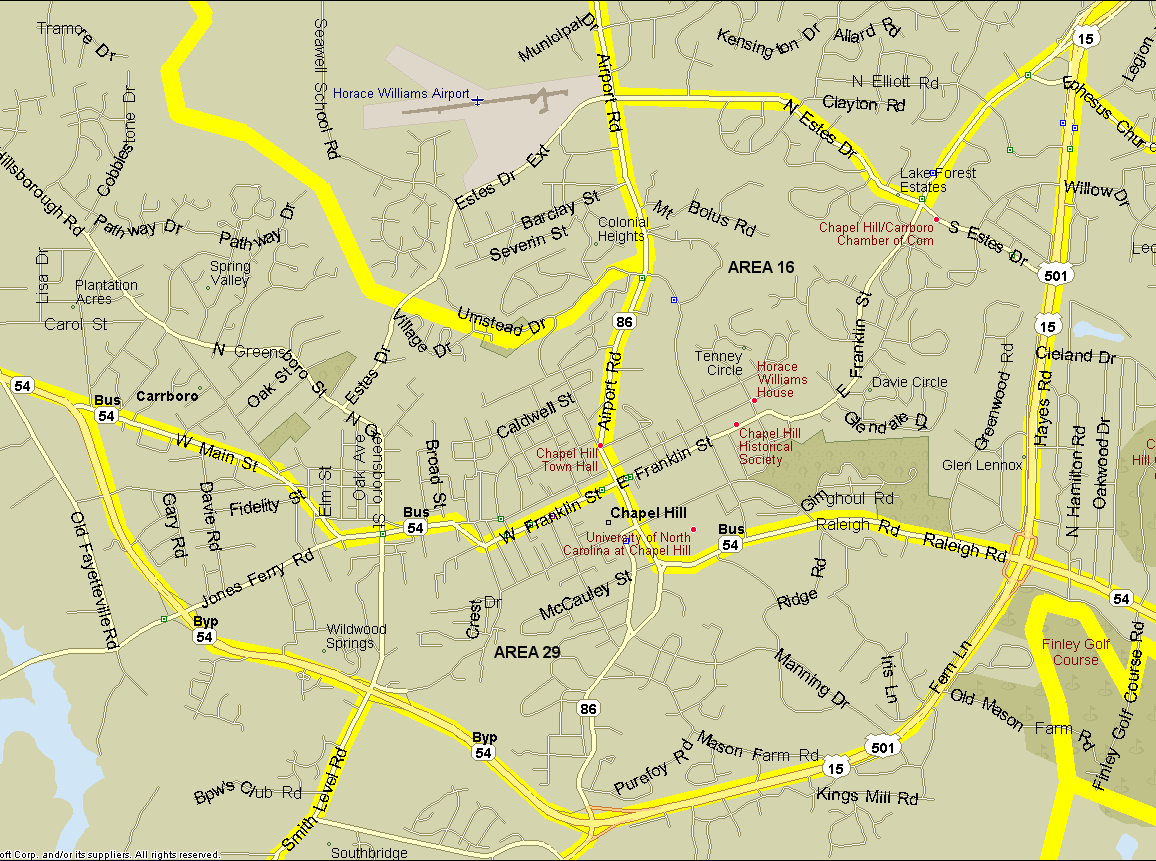Chapel Hill Bird Count Circle — areas 16 and 29
16. Central Chapel Hill area. Bounded on north by Estes Drive (from Airport Rd. to Franklin St.) and Franklin St. (from Estes to intersection with 15-501 bypass), east by US 15-501, south by Raleigh Rd./South Rd., and west by Airport Rd./Columbia St. Notes: A good spot to cover is the Bolin Creek Greenway between Franklin St. and Airport Road, which can be great for warblers in spring. One access point is at the end of Elizabeth St. Battle Park, an old-growth hardwood forest, is great for warblers in spring. The main campus of UNC is also in area 16, including the arboretum and McCorkle Place (home of a pair of Barred Owls). University Mall and Eastgate Shopping Center are worth checking for "trash birds", Cooper's Hawks, and Song Sparrows in spring.
Detailed tips from David and Judy Smith, regular counters of the area:
- We start at dawn on the Bolin Creek Trail, because it fills up with joggers and dog walkers early in the morning. If you have two cars, park one at one end (CH Police Department or the bridge on Bolinwood) or the other (Chapel Hill Community Park) and walk the length of the trail. There are good forest and scrub birds all along the trail – woodpeckers, sparrows, juncos, wrens, kinglets, and sometimes thrushes and hawks.
- From Chapel Hill Community Park, follow the Battle Branch Trail up to Sugarberry / Indian Springs Rd, looking for birds in the bushes. Turn left on Sugarberry and follow it until it ends, checking out feeders. The road ends at a pond on private land (don’t trespass) where we have seen Green and Great Blue Herons and Belted Kingfishers. The dirt road to the right of the pond, the continuation of Sugarberry, is public access. Follow it down as it bends to the right along the marshy sewer line easement, until it comes to 15-501 at the edge of the area. Then turn around and walk the easement (if it’s not too wet) between that private pond and Estes Drive, checking for sparrows, hawks, and scrub birds, until you emerge on Shepherd Lane, at the entrance to an apartment complex. Turn left on Shepherd and follow it through the complex, checking the pond on the right, where we have seen Great Blue Heron, then take the Battle Branch Trail back to the Community Center.
- The trees around and behind the Post Office on Estes Drive often attract Cedar Waxwings, robins, and other good birds.
- Spend some time in the Coker Arboretum on campus. We had a Northern Parula here one year, and there are many other possible birds.
- Other areas around campus, especially near the Bell Tower and the buildings along South Road near Columbia Street, can have flocks of robins and other birds.
- The area along the creek south of Eastgate Shopping Center (behind the Wild Bird Center) sometimes has birds in the bushes.
- Sharon and Bill Kirk have lots of feeders at their house on Maple Drive. One year they hosted a Rufous Hummingbird, and their yard is reliable for Brown-headed Nuthatches. We always contact them ahead of time at smkirk7@gmail.com.
29. South Town area. From Raleigh Rd./15-501 bypass intersection south and west along bypass to NC 54 business, and back east on 54 business to point of beginning. Notes: Urban and old suburban (with mature trees), there are a few patches of woods and city parks in the area.
Detailed tips from David and Judy Smith, regular counters of the area:
Most of this area is just housing, and we usually hit it in the afternoon, so we haven’t found much.
- The Coker Pinetum Trail, from Boshamer Stadium to Fern Lane, goes through nice forest. We have found a few hawks there.
- There are a few parks, including one on Purefoy Rd., that ought to have good birds, but we haven’t found much there.
- The Libba Cotten Bikeway from Roberson Street in Carrboro to Merritt Mill might have some good things.
- One very cold year, we found a Woodcock behind a dumpster near the intersection of Frankin and Columbia.
- There are occasional reports of Fish Crows flying over Franklin Street in December. We’ve never managed to find any.

Revised 12/22/2017 cwcook@duke.edu
Chapel Hill Bird Count Circle
